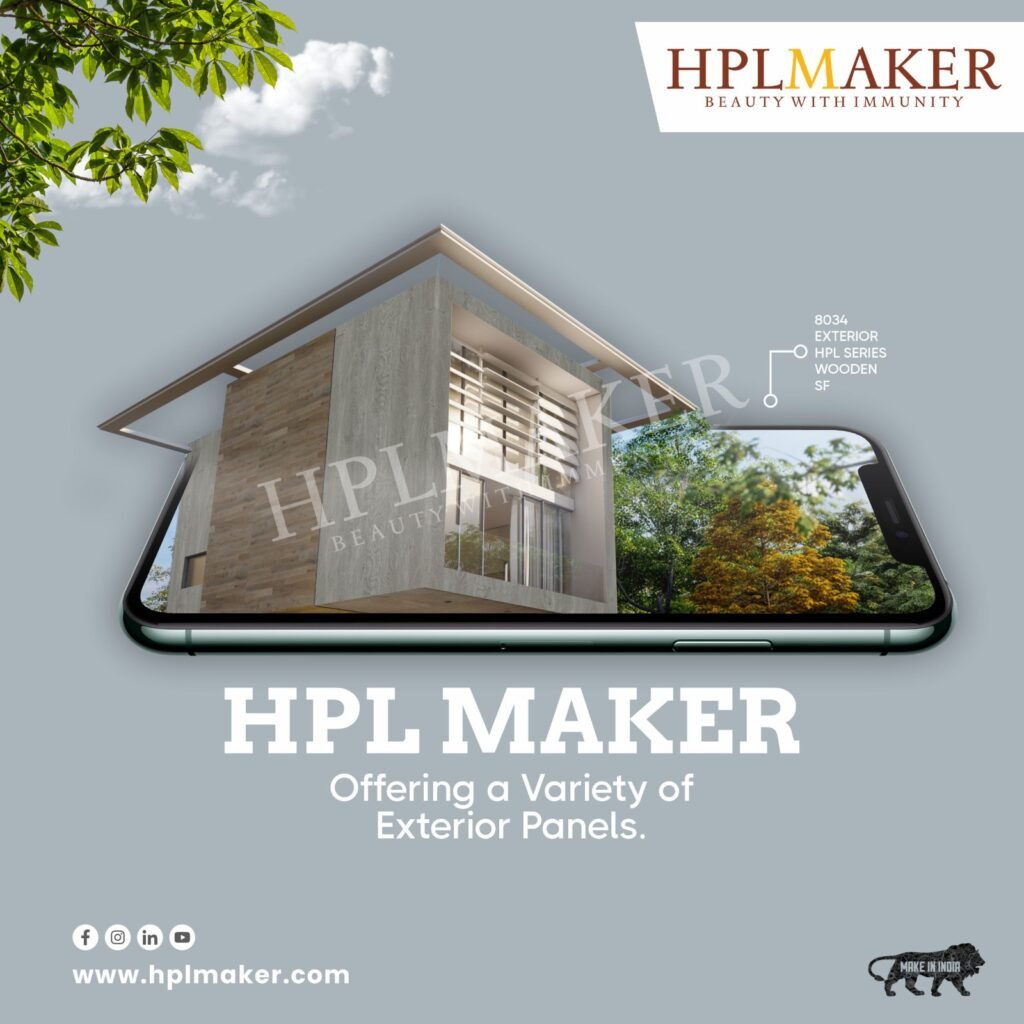Table of Contents
ToggleSpecifying Sustainability with HPL Maker
Choose Environment friendly option with HPL Maker
Why sustainability is important?
In recent years, the construction industry has seen a significant shift towards sustainability, with new projects increasingly prioritizing environment-friendly practices. Designers, traders, dealers, and constructors are at the forefront of this movement, advocating for the use of sustainable materials like High-Pressure Laminates (HPL) in both residential and commercial buildings.
HPL Maker is committed to providing sustainable and environment-friendly products, our HPL sheets are up to the global standard and we proudly name ourselves as an eco-friendly firm.
Embracing Sustainability in Construction
Stay future ready with sustainability!
Sustainable construction aims to minimize the environmental impact of buildings throughout their life cycle, from design and construction to operation and demolition. This involves using materials and methods that reduce waste, conserve natural resources, and promote energy efficiency. By incorporating sustainable practices, the industry can create healthier living and working environments, lower operational costs, and contribute to the global effort to combat climate change.
The Role of HPL in Sustainable Building
Multiple environment benefits to count -
High-pressure laminates (HPL) have become a preferred choice for sustainable buildings due to their numerous environmental benefits. HPL sheets are made from layers of paper and resin, compressed under high pressure to create a durable, versatile material. Here’s how HPL contributes to sustainable construction:
- Durability and Longevity:
- HPL sheets are highly resistant to wear, scratches, and moisture, ensuring a long lifespan. This reduces the need for frequent replacements and minimizes waste.
- Eco-Friendly Manufacturing:
- HPL Maker uses recycled materials and eco-friendly resins, resulting in lower environmental impact. The production process is designed to be efficient, minimizing resource use and waste.
- Energy Efficiency:
- When used in building facades, HPL can enhance thermal insulation, contributing to reduce energy consumption for heating and cooling.
- Low Emissions:
- HPL sheets with low volatile organic compound (VOC) emissions improve indoor air quality, creating healthier environments for occupants.
- Certifications and Compliance:
- HPL products often meet stringent environmental standards and certifications such as LEED, GREENGUARD, and FSC, ensuring they align with sustainable building practices.
Advocating for HPL in Home and Commercial Buildings
Bundle of benefits pack in one sheet -
As the demand for sustainable construction grows, designers, traders, dealers, and constructors are increasingly recommending HPL sheets for a variety of projects. Here’s why they are advocating for HPL in both residential and commercial buildings:
- Aesthetic Versatility: HPL offers a wide range of design options, from realistic wood grains to vibrant colors and custom prints, allowing for creative and personalized design solutions in homes and commercial spaces.
- Cost-Effective Solutions: The durability and low maintenance requirements of HPL make it a cost-effective choice for building owners. Its long lifespan reduces replacement costs, while its resistance to damage ensures that surfaces remain in good condition for years.
- Enhanced Building Performance: The use of HPL can contribute to overall building performance by improving energy efficiency and indoor air quality, which are crucial factors in sustainable construction.
- Market Demand: With increasing awareness of environmental issues, more clients are seeking sustainable building options. By recommending HPL Maker’s HPL sheets, industry professionals can meet this demand and differentiate themselves as leaders in sustainability.

High-Pressure Laminates (HPL) contribute to green building and sustainability in several ways:
1. Sustainable Materials and Manufacturing
- Recycled Content: We, HPL Maker use recycled materials in our products, reducing the need for virgin resources.
- Eco-Friendly Resins: Some HPLs are made with eco-friendly resins that have lower emissions of volatile organic compounds (VOCs), contributing to better indoor air quality.
- Certifications: HPL products often carry environmental certifications such as GREENGUARD, FSC (Forest Stewardship Council), and LEED (Leadership in Energy and Environmental Design) credits, ensuring they meet stringent sustainability standards.
- Durability and Longevity
- Extended Lifespan: HPL sheets are highly durable and resistant to scratches, impacts, and moisture, which mean they have a longer lifespan compared to other materials. This reduces the frequency of replacements and the associated environmental impact.
- Low Maintenance: Their ease of maintenance reduces the need for harsh cleaning chemicals and extensive resources for upkeep.
- Energy Efficiency
- Thermal Insulation: HPL can contribute to thermal insulation when used in building facades, reducing the energy required for heating and cooling the building.
- Resource Efficiency
- Material Efficiency: The manufacturing process of HPL is designed to maximize material efficiency, often resulting in less waste.
- Optimized Production: Modern manufacturing techniques optimize resource use and minimize waste, further contributing to sustainability.
- Recyclability and End-of-Life Management
- Recyclability: Some HPL products are recyclable at the end of their life cycle, reducing landfill waste.
- Take-back programs: Certain manufacturers offer take-back programs to ensure responsible disposal and recycling of HPL products.
- Low Emissions
- Reduced VOCs: HPL sheets with low VOC emissions contribute to healthier indoor environments and meet stringent air quality standards.
- Environmental Impact: The overall environmental impact of HPL is reduced through the use of low-emission resins and sustainable manufacturing processes.
Conclusion
“High-pressure laminates play a significant role in promoting green building and sustainability through their durable and eco-friendly properties. Their use of sustainable materials, certifications, long lifespan, and recyclability make them a favorable choice for environmentally conscious construction projects.”
Thus, the integration of High-Pressure Laminates in both residential and commercial construction is a testament to the industry’s commitment to sustainability. By leveraging the environmental benefits of HPL, designers, traders, dealers, and constructors can create buildings that are not only aesthetically pleasing and durable but also environmentally responsible. This shift towards sustainable materials like HPL is paving the way for a greener future in the construction industry.


